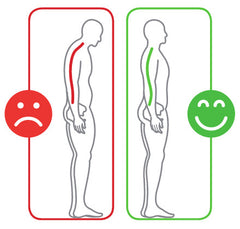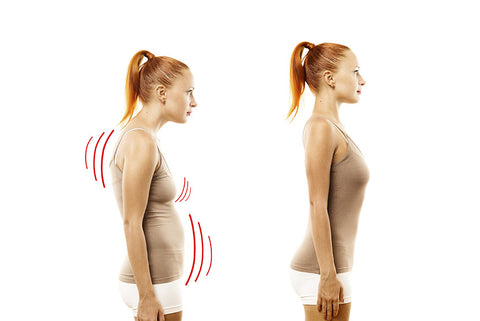Posture Tips Treatment
What is Good Posture?

Once you understand the health benefits that come as a result of moving throughout your life with optimal posture, it’s time to start making adjustments. If you’ve been sitting, standing, sleeping or moving with poor posture for your entire life, it’s going to take some time for your body and spine to adjust to being in proper alignment. Start small with some of the tips below and then continue to work on making your posture a priority. Trust us—it will be worth it!
Sitting Posture

- Sit up with your back firmly against the chair and hips upright.
- Choose a chair that allows you to rest both feet flat on the floor while keeping your knees level with your hips at a 90 degree angle.
- Stretch the top of your head toward the ceiling, tuck your chin in slightly and keep your shoulders relaxed.
- Keep your spine in proper “S” curvature with your ears above shoulders and shoulders above hips.
- Keep your monitor an arm’s length away from the face (about 18-24”) and at a height that allows your eyes to be focused 2-3” below the top of the monitor without straining your neck.
- Get up and take a break from sitting at least once an hour. Walk around the office, go up and down a flight of stairs or do some quick stretches.
- If you spend time sitting in your car, adjust your car seat similar to your office chair and make sure to use a proper pelvic support.
Standing Posture

- Balance your weight evenly on both feet.
- Keep your feet parallel.
- Pull in your abdomen and buttocks, making sure to keep hips upright (make sure not to overly arch your back with your buttocks pushed back).
- Keep your shoulders back and relaxed.
- Try not to tilt your head forward, backward or sideways, and make sure your knees are relaxed—not locked.
Sleeping Posture

- Don’t sleep on your stomach!
- Find a pillow that preserves the curve of your neck when sleeping on your back, and keeps your spine parallel to the bed for side sleep.
- Place a small pillow between your knees for side sleep, and under your knees for back sleep.
- Find a mattress with good support. Experts recommend a soft-top mattress with firm coils underneath.
Exercise and Occupational Posture

- Always lift with your legs and bend at the knees, not the hips. Allow your leg and abdomen muscles to do most of the work.
- Stand balanced with your feet planted (see Standing Posture).
- Keep your shoulders back and relaxed (remember: head over heart over hips).
- Participate in sports that are good for your specific condition, and always practice proper form when performing certain exercises.
Other Tips
Assess Your Current Posture. Wear something form-fitting and take two full-body photos—one from the front, one from the side. Relax your muscles and stand as tall as you can, feet hip-width apart.
When you view the pictures, take note of the following things:
Side
- Is your ear forward of your center line? (If YES, your head is too far forward.)
- Do you see your shoulder blade? (If YES, your back is too rounded.)
- Does your belly stick out? (If YES, you have an anterior pelvic tilt.)
Front
- Is one shoulder higher than the other?
- Is one knee higher than the other? (Both knees should point forward, they should not face inward.)
- Do your toes point excessively inward or outward (more than 10 degrees either way)?
Now that you can see what your posture really looks like, make a conscious effort to fix the areas you need addressed.
 Imagine a String Pulling Your Head Up. Think of a straight line passing through your body from the ceiling to the floor (your ears, shoulders, hips, knees, and ankles should be even and line up vertically). Now imagine that a strong cord attached to your breastbone is pulling your chest and rib cage upward, making you taller. Try to hold your pelvis level—don’t allow the lower back to sway. Think of stretching your head toward the ceiling, increasing the space between your rib cage and pelvis.
Imagine a String Pulling Your Head Up. Think of a straight line passing through your body from the ceiling to the floor (your ears, shoulders, hips, knees, and ankles should be even and line up vertically). Now imagine that a strong cord attached to your breastbone is pulling your chest and rib cage upward, making you taller. Try to hold your pelvis level—don’t allow the lower back to sway. Think of stretching your head toward the ceiling, increasing the space between your rib cage and pelvis.